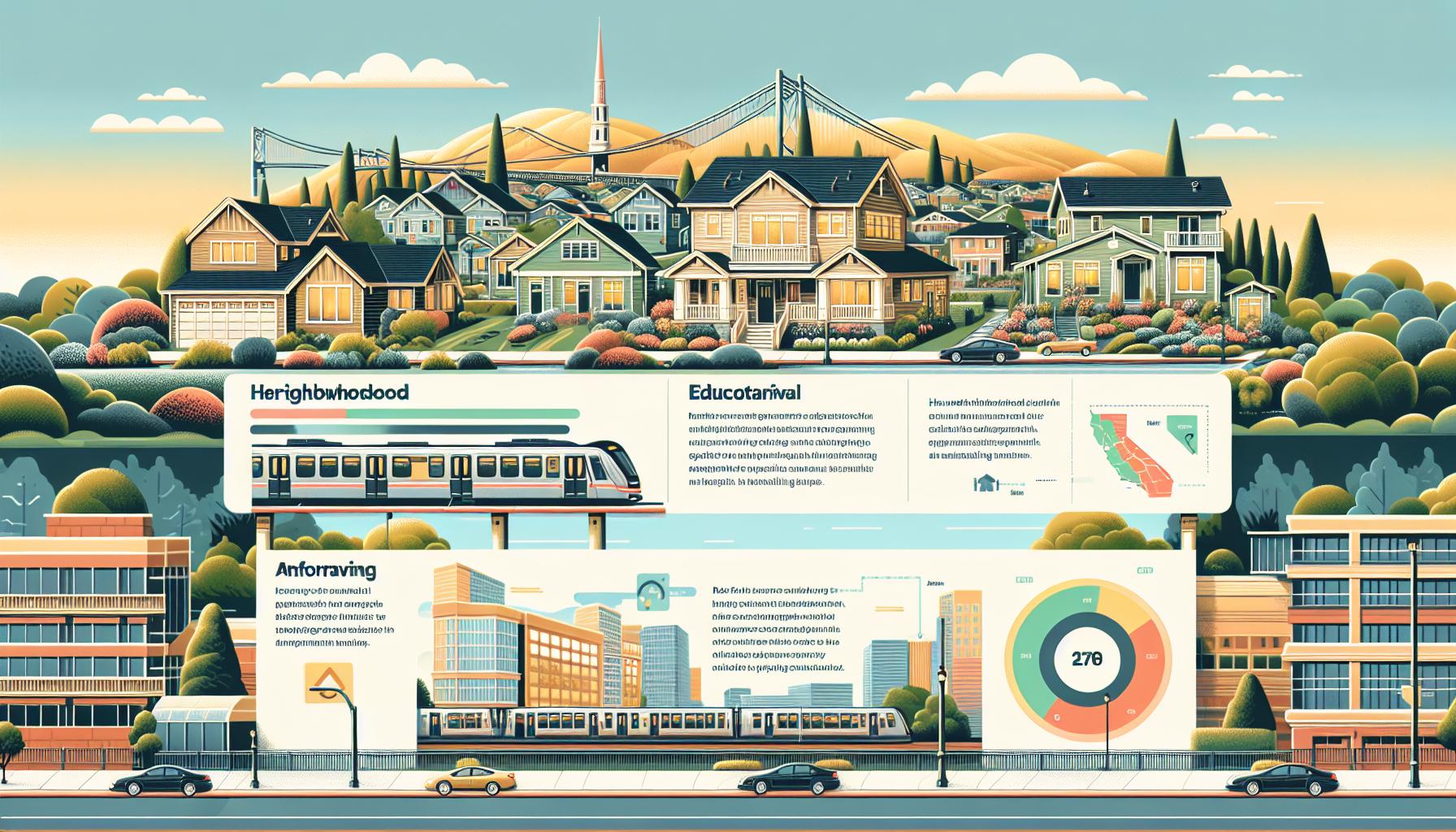Key Takeaways
- Hayward offers strong real estate investment potential due to its growing population, diverse community, and proximity to major Bay Area cities like San Francisco and Oakland.
- Economic growth, job market stability, and local infrastructure developments enhance rental demand and property value trends in the area.
- Investors can choose from a variety of property types, including single-family homes, multi-family units, and commercial properties, catering to different investment goals and tenant demographics.
- Rental yields in Hayward range from 3% to 5%, with areas near transit hubs, schools, and employment centers offering higher demand and income stability.
- Staying updated on local regulations, including rent control laws and property taxes, is essential for avoiding unexpected financial obligations and maximizing profitability.
- Analyzing long-term ROI through market trends, neighborhood-specific insights, and maintenance planning ensures better decision-making for property investments in Hayward.
Investing in property can feel like a big step, especially in a dynamic market like Hayward. You might be wondering if this city offers the right opportunities for your financial goals or how to make sense of the numbers behind a potential investment. These are important questions, and getting clear answers is the first step toward making confident decisions.
Hayward’s growing appeal makes it an intriguing choice for investors, but how do you assess its true potential? From rental demand to property values, there’s a lot to consider. I’ll break down the key factors to help you approach your investment with clarity and focus. Whether you’re new to property investments or looking to refine your strategy, understanding the market here is essential. Ready to dive in? Let’s explore what makes Hayward worth a closer look.
Understanding Hayward As A Real Estate Market
Hayward stands out with its diverse community and growing population. It’s located in the Bay Area, offering proximity to major cities like San Francisco and Oakland. This accessibility attracts both commuters and renters, creating consistent demand for housing.
Local economic growth has added to Hayward’s appeal. The city benefits from a mix of industries, including technology, retail, and healthcare, which boosts employment opportunities. Steady job availability often translates into reliable rental income for property owners.
Property types in Hayward vary widely. Options range from single-family homes and duplexes to larger apartment complexes. Investors can target different segments based on their goals, whether focusing on family-oriented neighborhoods or urban rental markets.
Housing prices and rental rates have shown upward trends over recent years. While competitive, Hayward’s market remains more affordable compared to other Bay Area cities. This affordability makes it attractive to both renters and investors looking for a balance of cost and potential return.
What piques your interest when analyzing a market like Hayward? Staying informed about local developments, zoning changes, and neighborhood dynamics can shape smart investment strategies.
Factors Influencing Investment Properties In Hayward

Investment decisions in Hayward depend on multiple factors that shape the market’s potential. Understanding these elements helps in assessing opportunities effectively.
Economic Growth And Job Market
Hayward’s economic expansion drives demand for rental properties. The city benefits from its proximity to San Francisco and Oakland, attracting professionals in sectors like tech, healthcare, and retail. Local businesses create employment opportunities, increasing the purchasing power of residents and sustaining steady housing demand.
Job market stability ties directly to rental income reliability. A diverse employment base reduces risks during broader economic shifts. How do you factor job availability into your investment analysis? Observing companies expanding or relocating to Hayward could signify long-term growth.
Population Trends And Demographics
Population increases, including the growing number of young professionals and families, support rental market strength. Hayward’s diverse community fosters cross-cultural appeal, which attracts renters from varying backgrounds. Families often seek housing near quality schools, while younger adults prioritize transit access or downtown amenities.
Consider evaluating the demographic segments likely to rent in the area. Are you aligning property features—like layout or location—with the preferences of your target audience? Population shifts, even within specific neighborhoods, can influence future returns.
Infrastructure And Development
Continued development transforms Hayward into a commuter-friendly, resource-rich location. Investments in public transit systems, like expanded BART access, reduce commute times to nearby cities. Mixed-use projects, combining retail, residential, and office spaces, stimulate neighborhood improvements.
Infrastructure upgrades enhance convenience for tenants, helping properties retain value. Future developments—bike paths, parks, or road expansions—can increase desirability. What infrastructure changes do you see influencing property values over the next five years? Anticipating such projects might provide a competitive edge in the market.
Types Of Investment Properties In Hayward

Hayward offers a range of investment opportunities across property types. Each category caters to different investor goals and tenant needs. What type of property aligns best with your investment strategy?
Residential Properties
Residential properties appeal to investors looking for stable, long-term returns. These include single-family homes and condominiums. Single-family homes, for example, are in demand among young families due to Hayward’s schools and community-oriented neighborhoods. Condominiums often attract professionals seeking low-maintenance living near transit hubs.
Their popularity stems from consistent tenant demand. Many renters prioritize proximity to amenities like parks, shopping centers, and public transportation. A focus on these areas can help secure steady rental income.
Commercial Properties
Commercial properties provide an option for those interested in targeting businesses. These may include office spaces, retail stores, or warehouses. Hayward’s central location within the Bay Area supports business activity, driving demand for these spaces.
Businesses in technology, healthcare, and retail sectors actively seek lease opportunities here. For example, retail properties near popular shopping districts often benefit from consistent foot traffic, enhancing revenue potential for owners.
Multi-Family Units
Multi-family units appeal to investors focused on scaling rental income. Examples include duplexes, triplexes, or apartment buildings. Hayward’s growing population and diverse demographics increase interest in these types of housing.
Young professionals and families often seek apartments because of affordability compared to single-family homes. Owning multi-family units allows me to accommodate multiple tenants, diversifying income streams and spreading risk across different leases.
Analyzing Property Value Trends In Hayward

Understanding property value trends in Hayward helps identify investment opportunities and manage financial expectations. Evaluating historical and current data provides essential insights into market behavior.
Historical Price Trends
Over the past decade, Hayward’s property prices have steadily increased. In 2013, median home prices averaged $400,000. By 2023, this figure rose to approximately $900,000, reflecting a 125% growth. This trend aligns with the expanding Bay Area real estate market, driven by increased demand from commuters and local growth.
Specific neighborhoods like Fairview and Jackson Triangle have experienced notable appreciation due to their proximity to transit hubs and retail centers. For instance, properties near BART stations saw higher value increases compared to areas further from public transit access.
How have historical changes in property costs affected your investment strategy? Analyzing past trends can guide expectations and prepare for potential market shifts.
Current Market Conditions
Hayward’s current market remains competitive, with a median home price of around $900,000 in 2023. Rental properties, especially multi-family units, are in high demand due to population growth and housing shortages. Rental rates average $2,300–$3,500 monthly for apartments, depending on size and location.
Ongoing developments, including new residential constructions and mixed-use projects, contribute to demand. Areas under redevelopment, such as Downtown Hayward, are seeing increased investor interest due to revitalization efforts.
Are current housing prices influencing your decision to invest or wait? Staying updated on neighborhood-specific trends could clarify future opportunities.
Evaluating Potential ROI And Risks

Analyzing potential returns and understanding associated risks are key to making informed property investment decisions in Hayward. I examine several critical factors that can influence both profitability and challenges in this market.
Rental Yields And Income
Assessing rental yields helps determine the profitability of an investment property. In Hayward, average gross rental yields for single-family homes range from 3% to 5%, driven by strong rental demand. Additional evaluation of net rental yields, after subtracting expenses like property management fees and maintenance, provides a clearer picture of income potential.
Specific property types can influence income levels. Multi-family units, for example, often generate higher cumulative rental income by accommodating multiple tenants. To maximize returns, I focus on neighborhoods with high demand, like those near BART stations, schools, or employment hubs. What strategies are you considering to attract long-term tenants and maintain steady income?
Market Volatility
Real estate value fluctuations can impact both short-term rental income and long-term appreciation. In Hayward, past property appreciation rates reflect market competition, with home prices growing 125% from 2013 to 2023. Although this trend points to potential growth, external economic factors, like interest rate changes or employment shifts, could increase risks.
Tracking market health, such as supply-demand imbalances or extended vacancy periods, helps me anticipate challenges. During volatile periods, focusing on properties in stable rental areas minimizes losses. Have you identified any specific indicators signaling when to adjust your investment plans?
Local Regulations And Taxes
Understanding Hayward’s property regulations and tax policies helps prevent unexpected financial setbacks. The city imposes rental control ordinances on specific units, capping annual rent increases to protect tenants. Staying updated on these policies allows property owners to plan lease adjustments accordingly.
Property taxes in Hayward typically align with Alameda County rates, hovering around 1.1% of assessed value. Additional costs, like Mello-Roos taxes in some areas, can affect overall expenses. Staying informed about local tax policies is essential to avoid surprises. What additional financial evaluations could help streamline your budgeting process?
Tips For Successful Investment In Hayward

Research Local Market Trends
I always prioritize studying housing market trends in Hayward before making decisions. Factors like property appreciation rates, average rental yields, and demand in specific neighborhoods provide valuable insights. Neighborhoods with proximity to transit hubs, schools, and retail centers often experience steady demand.
Assess Property Types
Identifying the right property type depends on goals and target tenants. Single-family homes typically attract families seeking stability. Multi-family units often generate higher rental income due to shared expenses across tenants. Commercial properties require analysis of business activities in the area.
Focus On Tenant Demographics
Understanding who rents properties in Hayward helps make effective investments. Young professionals often look for rentals near transit options, while families prefer larger spaces with access to schools and parks. Aligning property features with their needs can increase occupancy rates.
Monitor Economic Indicators
I find it helpful to keep track of Hayward’s economic health. Job market stability and the presence of diverse industries enhance rental demand. Areas near growing business hubs or with planned infrastructure development often hold greater potential.
Stay Updated On Local Policies
Familiarity with city regulations helps avoid unexpected expenses. Reviewing rent control laws, zoning restrictions, and property tax rates ensures long-term financial viability. Local ordinances directly affect rental pricing and profit margins.
Budget For Property Upkeep
Allocating funds for maintenance is essential for retaining property value and attracting tenants. Regular inspections help address small issues before they become expensive repairs. Updated amenities like energy-efficient appliances often appeal to renters.
Analyze Long-Term ROI
Profitability is linked to both rental income and property appreciation. Estimating expenses, including mortgages, taxes, and maintenance, provides a clear picture of potential gains. Properties with balanced initial costs and steady rental demand yield more predictable returns.
What strategies have worked best for you in managing investment properties?
Conclusion
Hayward’s real estate market presents a dynamic landscape filled with opportunities for investors who are prepared to do their homework. From its strategic location to its diverse property options, the city offers a unique blend of affordability and growth potential. Staying informed about market trends, economic factors, and local developments is key to making smart investment decisions. With the right strategy, Hayward can be a rewarding choice for both seasoned and first-time investors looking to build long-term wealth.
Frequently Asked Questions
Why is Hayward a good location for real estate investment?
Hayward’s growing population, diverse community, and proximity to major cities like San Francisco and Oakland make it a prime location for real estate investment. Its affordability compared to other Bay Area cities, coupled with local economic growth and job opportunities, attracts renters and ensures consistent demand.
What types of properties are available for investment in Hayward?
Hayward offers a variety of properties, including single-family homes, condominiums, multi-family units, and commercial spaces. Investors can choose based on their goals, with options catering to families, professionals, and businesses.
How has Hayward’s property market grown in recent years?
Over the last decade, Hayward’s property values have appreciated significantly, with median home prices rising from $400,000 in 2013 to around $900,000 in 2023. Certain neighborhoods, like Fairview and Jackson Triangle, have seen particularly strong growth.
What drives rental demand in Hayward?
Rental demand in Hayward is driven by its central location, population growth, influx of young professionals and families, and economic stability. Job opportunities in sectors like technology, retail, and healthcare further increase renter interest.
What is the typical ROI on Hayward property investments?
Rental yields for single-family homes in Hayward typically range from 3% to 5%, while multi-family units offer higher cumulative income due to multiple tenants. Long-term appreciation also contributes to strong ROI in the city’s competitive market.
What are the risks of investing in Hayward real estate?
Potential risks include market volatility, property value fluctuations, and unexpected financial impacts from local regulations like rent control or property taxes. Thorough research and planning can help mitigate these risks.
Which neighborhoods in Hayward are best for investment?
Neighborhoods like Fairview and Jackson Triangle are highly sought after due to their proximity to transit hubs, retail centers, and ongoing revitalization efforts. Downtown Hayward also shows promise with its development projects.
Are there opportunities for multi-family property investments in Hayward?
Yes, multi-family units like duplexes and apartment buildings are in high demand, particularly among young professionals and families. These properties often generate higher rental income and cater to Hayward’s growing population.
How can infrastructure developments impact property investments?
Ongoing infrastructure projects, such as improved public transit and mixed-use developments, enhance Hayward’s appeal by increasing accessibility and boosting property values. These developments present growth opportunities for investors.
What are practical tips for successful investments in Hayward?
To invest successfully in Hayward, research local property trends, focus on high-demand neighborhoods, align property features with tenant preferences, and monitor economic indicators and regulations. Budgeting for maintenance and long-term ROI analysis is also essential.
